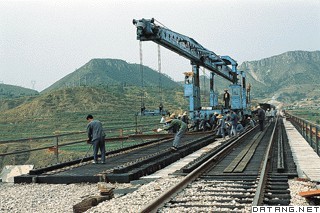1) model track diagram


轨道模型图[盘]
2) trajectory model


轨道模型
1.
Application of stochastic trajectory model in tail-nozzle SRM flow field numerical simulation;
随机颗粒轨道模型在长尾喷管发动机流场计算中的应用
2.
It is suggested that the part ide- motion- resolution trajectory model is efficient for simulating the dynamic behavior of circulating fluidized beds.
运用颗粒运动分解轨道模型模拟了循环流化床中的宏观非均匀结构,模拟结果给出了与实验结果相吻合的空隙率分布、颗粒速度分布及气体速度分布。
3.
In order to provide analysis results for fault diagnosis in a tailpipe nozzle to make some suggestions,twophase flow field is studied for a tailpipe nozzle by using the trajectory model and finite volume method to obtain the gas temperature and Mach number distributions,and to simulate the collision between the wall and different size particles under different total pressures.
为了给长尾喷管故障诊断提供理论依据并提供改进措施,利用颗粒轨道模型和有限体积的Jameson格式计算了长尾喷管两相流流场,得到了流场中温度和马赫数的分布和不同燃烧室总压下不同尺寸的粒子对喷管壁面的撞击情况,结果表明大尺寸粒子对直管段壁面的撞击位置存在一个集中点,这是造成喷管烧穿的重要原因。
3) track model


轨道模型
1.
Analysis of vehicle-track system vibration (Comparison between Timoshenko beam and Euler beam track model);
车辆-轨道系统振动响应分析——Timoshenko梁与Euler梁轨道模型的比较
2.
Meanwhile,for a droplet falling freely under gravity with horizontal projection,the track model and the longest distance in both horizontal and vertical directions are obtained.
建立重力作用下作平抛运动液滴的轨道模型,得出了水平方向与竖直方向上的最大输运距离。
4) orbit model


轨道模型
1.
This paper presents an orbit model capable of being applied to the collaboration of enterprises in supply chains of which the members locate in different orbits around the core enterprise in accordance with the degree in which they collaborate.
文章主要介绍了轨道模型在供应链企业合作中的应用 ,根据合作程度的不同 ,伙伴企业处于以核心企业为中心的不同轨道。
5) four-obital model


四轨道模型
6) particle-trajectory model


颗粒轨道模型
1.
In this paper, the quantity of liquid droplets condensed from heavy fractions of FCC products due to temperature decrease was calculated, and a particle-trajectory model was used to simulate the flow tracks of these droplets.
首先求取了单位时间沉降器内冷凝的油浆液滴的质量,然后利用颗粒轨道模型对液滴的运动轨迹进行模拟计算,得到液滴的停留时间、运动轨迹和分布区域。
2.
With continuously increasing computer power, the determinate particle-trajectory model (DPTM) is progressing very quickly in the multisca.
随着计算机硬件的发展 ,基于颗粒尺度模拟稠密气固两相流的颗粒轨道模型发展很快 。
补充资料:轨道
| 轨道 track 直接支承机车车辆运行并导引机车车辆行驶的铁路路基上部的结构。
轨道结构自下而上分别是设于路基顶面的道床、埋置于道床的轨枕,以及由联结部件与轨枕相接的钢轨。道床的作用是将本身及其以上的动荷载与静荷载传给路基,并防止轨枕发生位移,使之相互间保持一定间隔。道床由规定级配的良好碎石构成,铁路正线上的道床有时在下部敷设一层垫层。道床的厚度与宽度按铁路等级确定,中国规定为25~50厘米厚。轨枕用以承受钢轨传来的荷载并连同本身重量一起传给道床,在轨枕上固定钢轨,保持一定的轨距。按轨枕所用材料主要有木质轨枕,其弹性好且便于施工;钢筋混凝土轨枕,坚固耐用,但重量大,弹性较差;钢枕,抗虫蛀和抗腐蚀,但易受化学性侵蚀,维修费高。中国铁路直线上每千米敷设轨枕为1600根、1760根和1840根,视行车速度与运量等因素确定。钢轨是轨道最上部的结构,直接承受车轮荷载并导引机车车辆行驶。在电气化铁路中,钢轨还兼有电路的作用。常用钢轨有碳素钢和中锰钢材质,其种类以单位长度的重量划分:以英制计量有每码(1码=0.9144米)90磅(1磅=0.4536千克)、112磅和132磅等;中国钢轨每米重43千克、65千克、50千克和60千克等;轻型钢轨重量均低于这些重量。选取钢轨的种类,主要依据是机车车辆的轴重、行车速度和运量等。钢轨与钢轨的联结部件为鱼尾板、螺栓等;钢轨与轨枕的联结部件为垫板、扣铁、道钉、防爬器和轨距杆等。 轨距是两股钢轨头部内侧之间的最短距离。有标准轨距、窄轨距、宽轨距3种。标准轨距为1435毫米;窄轨距小于1435毫米,常见的有1067毫米、1000毫米(又称米轨距)、762毫米和610毫米;宽轨距大于1435毫米,常见的有1524毫米、1600毫米和1676毫米等。 |
说明:补充资料仅用于学习参考,请勿用于其它任何用途。
参考词条
